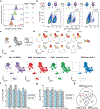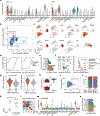Transcript-specific enrichment enables profiling of rare cell states via single-cell RNA sequencing
- PMID: 39779958
- PMCID: PMC12276987
- DOI: 10.1038/s41588-024-02036-7
Transcript-specific enrichment enables profiling of rare cell states via single-cell RNA sequencing
Abstract
Single-cell genomics technologies have accelerated our understanding of cell-state heterogeneity in diverse contexts. Although single-cell RNA sequencing identifies rare populations that express specific marker transcript combinations, traditional flow sorting requires cell surface markers with high-fidelity antibodies, limiting our ability to interrogate these populations. In addition, many single-cell studies require the isolation of nuclei from tissue, eliminating the ability to enrich learned rare cell states based on extranuclear protein markers. In the present report, we addressed these limitations by developing Programmable Enrichment via RNA FlowFISH by sequencing (PERFF-seq), a scalable assay that enables scRNA-seq profiling of subpopulations defined by the abundance of specific RNA transcripts. Across immune populations (n = 184,126 cells) and fresh-frozen and formalin-fixed, paraffin-embedded brain tissue (n = 33,145 nuclei), we demonstrated that programmable sorting logic via RNA-based cytometry can isolate rare cell populations and uncover phenotypic heterogeneity via downstream, high-throughput, single-cell genomics analyses.
© 2025. The Author(s), under exclusive licence to Springer Nature America, Inc.
Conflict of interest statement
Competing interests: A.T.S. is a founder of Immunai, Cartography Biosciences, Santa Ana Bio and Prox Biosciences, an advisor to Wing Venture Capital and receives research funding from Astellas and Merck Research Laboratories. R.R.S., L.S.L. and C.A.L. are consultants to Cartography Biosciences. R.C. is a consultant for Sanavia Oncology, S2 Genomics and LevitasBio. The other authors declare no competing interests.
Figures












Update of
-
Transcript-specific enrichment enables profiling rare cell states via scRNA-seq.bioRxiv [Preprint]. 2024 Mar 27:2024.03.27.587039. doi: 10.1101/2024.03.27.587039. bioRxiv. 2024. Update in: Nat Genet. 2025 Feb;57(2):451-460. doi: 10.1038/s41588-024-02036-7. PMID: 38586040 Free PMC article. Updated. Preprint.
Similar articles
-
Transcript-specific enrichment enables profiling rare cell states via scRNA-seq.bioRxiv [Preprint]. 2024 Mar 27:2024.03.27.587039. doi: 10.1101/2024.03.27.587039. bioRxiv. 2024. Update in: Nat Genet. 2025 Feb;57(2):451-460. doi: 10.1038/s41588-024-02036-7. PMID: 38586040 Free PMC article. Updated. Preprint.
-
Single nucleus DNA sequencing of flow sorted archived frozen and formalin fixed paraffin embedded solid tumors.BMC Genomics. 2024 Oct 8;25(1):943. doi: 10.1186/s12864-024-10850-w. BMC Genomics. 2024. PMID: 39379794 Free PMC article.
-
DiSC: a statistical tool for fast differential expression analysis of individual-level single-cell RNA-seq data.Bioinformatics. 2025 Jun 2;41(6):btaf327. doi: 10.1093/bioinformatics/btaf327. Bioinformatics. 2025. PMID: 40444783 Free PMC article.
-
Single-cell RNA sequencing in pediatric research: Focusing on differentiation trajectories and immune microenvironment of neuroblastoma.Pediatr Discov. 2024 May 23;2(3):e61. doi: 10.1002/pdi3.61. eCollection 2024 Sep. Pediatr Discov. 2024. PMID: 40625458 Free PMC article. Review.
-
Discoveries in Retina Physiology and Disease Biology Using Single-Cell RNA Sequencing.Front Biosci (Landmark Ed). 2023 Oct 19;28(10):247. doi: 10.31083/j.fbl2810247. Front Biosci (Landmark Ed). 2023. PMID: 37919055
Cited by
-
EnrichSci: Transcript-guided Targeted Cell Enrichment for Scalable Single-Cell RNA Sequencing.bioRxiv [Preprint]. 2025 May 8:2025.05.02.651937. doi: 10.1101/2025.05.02.651937. bioRxiv. 2025. PMID: 40654882 Free PMC article. Preprint.
-
Robust self-supervised machine learning for single cell embeddings and annotations.bioRxiv [Preprint]. 2025 Jun 8:2025.06.05.658097. doi: 10.1101/2025.06.05.658097. bioRxiv. 2025. PMID: 40502088 Free PMC article. Preprint.
-
Unveiling heterogeneity in rare cells by combining RNA-based sorting and scRNA-seq.Nat Genet. 2025 Feb;57(2):283-284. doi: 10.1038/s41588-024-02073-2. Nat Genet. 2025. PMID: 39920268 No abstract available.
References
MeSH terms
Grants and funding
- UM1 HG012076/HG/NHGRI NIH HHS/United States
- UM1HG012076/U.S. Department of Health & Human Services | NIH | National Human Genome Research Institute (NHGRI)
- R00 HG012579/HG/NHGRI NIH HHS/United States
- U01 AT012984/AT/NCCIH NIH HHS/United States
- P30CA008748/U.S. Department of Health & Human Services | NIH | National Cancer Institute (NCI)
LinkOut - more resources
Full Text Sources

